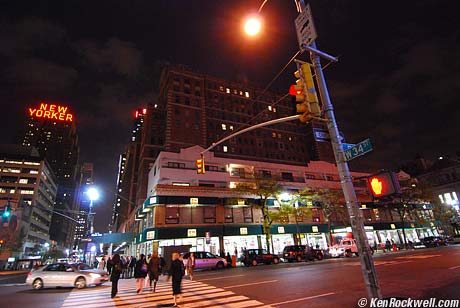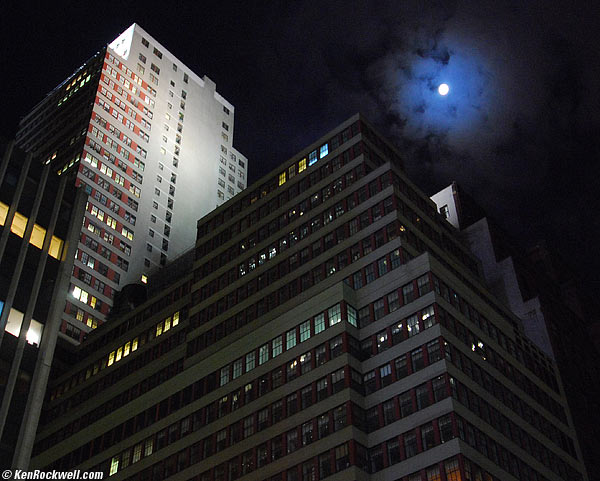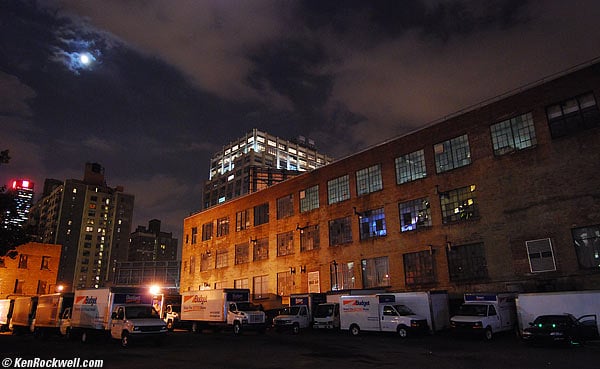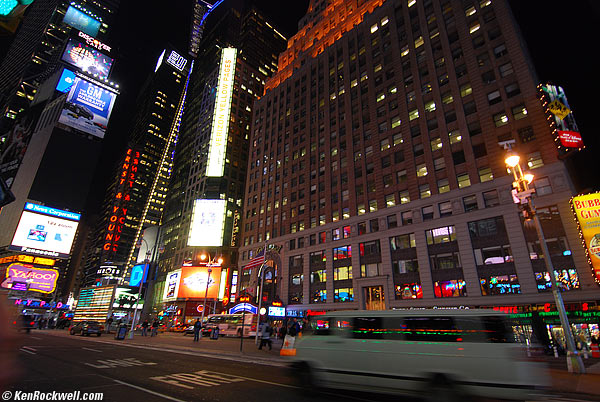Home Search Gallery How-To Books Links Workshops About Contact
|
Digital Killed My Tripod I get my goodies at Ritz and Amazon, and I bought my last tripod from Adorama 15 years ago. It helps me publish this site when you get yours from those links, too.
Manhattan. D80, 12-24mm @ 12mm, Auto ISO @ 1,600, f/4 @ 1/10 hand-held. INTRODUCTION Many people still cling to the mystique of the tripod, even though tripods went out with film cameras. Hang onto your tripod if you're shooting a real camera like a Hasselblad, Gandolfi, Linhof, Silvestri, Horseman, Tachihara, Gilde, Seitz, Sinar or even a Wisner, Wista or Mamiya, but toss it if you're shooting a popular digital SLR. Also hang on to your pod if you don't have IS or VR on your telephoto yet, and for very long time exposures. Tripods are no longer required, and actually often degrade sharpness, because shutter speeds have climbed and IS and VR lenses reduced the need for slower speeds. The new factors which have buried the tripod over just the past couple of years are: 1.) IS and VR lenses eliminate blur caused by camera motion. 2.) Smaller-than-35mm-format sensors use shorter lenses, which have plenty of depth of field at larger apertures. 3.) Diffraction becomes more significant with smaller format sensors, making smaller apertures like f/16 off limits because diffraction makes images visibly softer with today's high-resolution cameras. Compact point-and-shoot cameras have much smaller sensors, and have no apertures smaller than f/8 for exactly this reason. 4.) Better lenses which are sharp wide open. We used to need to stop down a couple of stops for optimum sharpness. 5.) Today's digital SLRs' have spectacular quality at high ISOs, if you're in marginal light. Shoot at ISO 400, 800 and 1,600 on a DSLR and the results are as good as slow film used to be. Sadly many people still look like idiots using tripods with digital cameras in daylight. These guys are throwbacks to the 1950s, or the early 2000s. Most people associate tripods with professional photography because they were required for the first two centuries of photography. High school photo teachers have been scaring students with "use a tripod or your photos will be fuzzy" stories for decades. This was the case before digital. I took a class from Susan Coppock in San Diego in the 1980s. She taught us that any time you set up a tripod in a national park, every tourist is going to stop and take pictures right next to you, even if you're in the middle of nowhere. They see a tripod and presume you are a professional photographer, and must therefore have discovered the one and only best place from which to make a picture. If you love your tripod then don't let me poop in your ice cream; but if you're carrying it around to use with your Canon or Nikon DSLR because someone else told you it made sharper pictures, think again. I make more and better pictures when I'm not weighed down.
Manhattan at Night. D80, 12-24mm @ 24mm, Auto ISO @ 1,400, f/4 @ 1/8 hand-held. The First Century Photography was invented in France in the mid-1800s. Photographic materials were so slow (insensitive to light) that exposures took hours in direct sunlight. You needed a tripod not just to hold the camera steady; you needed it to hold the camera while the photo exposed! Not only did you need to leave the camera on a support, braces were used to hold people still for the long exposures! That's why people looked so dull and bored in old photos. People weren't bored in the old days, but that was the only expression they could hold steady for a sharp ten-minute exposure. The Mid-1900s Serious amateur and professional photographers shot large format cameras, 4x5" and larger. Large format cameras use bigger film and therefore longer lenses. These longer lenses require smaller apertures to get decent depth of field. f/16 - f/32 are commonly used apertures, so you're often shooting at 1/8 second in daylight. I still do this with my own 4x5" camera, and of course you use a tripod. Photo materials progressed quickly, but in the mid-1900s ASA (ISO) 100 film was still considered super-speed. 35mm cameras, with their faster and shorter lenses, were only used by sissies and snapshooters. Look at a photo magazine from the 1940s or 1950s: amateurs used 5x7" cameras for shots of their babies, and pros shot 8 x 10!" 4x5" was a small format for slackers. Kodachrome was the first popular color film. It was ASA (ISO) 10 for decades. That's ten, not 100.
Scary Manhattan. D80, 12-24mm @ 16mm, Auto ISO @ 1,600, f/4 @ 1/4 hand-held. 1970s - 1980s 35mm cameras became popular with hobby photographers. Kodachrome gained speed from ASA (ISO) 10 to ASA 25. Kodak eventually created Kodachrome 64, whoo hoo! With 35mm cameras and these blazing speeds one finally could get a sharp shot without a tripod in broad daylight, but only with normal and wide lenses. If you wanted to stop down for depth of field or needed a telephoto lens, you still needed a tripod. 1990s Canon introduces the 28-135mm IS (image stabilization) lens. I always coveted that lens, but since I shot Nikon I was out of luck. With that lens you could throw away the tripod if you shot 35mm. Today If you're shooting a digital SLR, forget the tripod. The tripod only gets in the way and encourages the misuse of smaller apertures which soften images. Don't shoot at smaller than f/8 or f/11 unless you really need it. Unlike with film, digital sensors in 2007 have such high resolution that we easily can see the veiling effects of diffraction. Half the time that someone sends me a soft image they can't figure out, it's because they were blindly shooting at f/22 on a tripod. f/22 in digital softens the image exactly like squinting your eyes. I hated having to haul around a tripod and its crippling effects on letting me setup where I want. Don't be a turkey: leave your tripod in your trunk until after dark. Only pull it out for moonscapes. If the light is marginal, shoot several frames and pick the sharp one later. I shoot indoors and at night all the time without a tripod, and get more dynamic images because I'm free to move around and experiment.
Times Square at Night. D80, 12-24mm @ 12mm, Auto ISO 200, f/4 @ 1/15 hand-held. Note flying bus! Still Think Tripods Make Sharper Images? Try it yourself. Make a shot from your 'pod at f/22. Then pick up your tool in your own bare hands and make some shots at f/8 or wider. Look for yourself. It's obvious.
PLUG If you find this as helpful as a book you might have had to buy or a workshop you may have had to take, feel free to help me continue helping everyone. Thanks for reading! Ken
Caveat: The ads below come from a third party and I don't see or approve them. They are sent to your screen directly from a third party. They don't come from me or my site. See more at my Buying Advice page. Personally I get my goodies at Ritz, Amazon and Adorama. |
Home Search Gallery How-To Books Links Workshops About Contact







